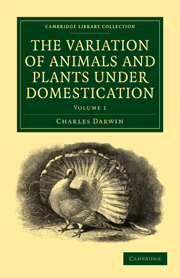Book contents
- Frontmatter
- Contents
- LIST OF ILLUSTRATIONS
- INTRODUCTION
- CHAPTER I DOMESTIC DOGS AND CATS
- CHAPTER II HORSES AND ASSES
- CHAPTER III PIGS — CATTLE — SHEEP — GOATS
- CHAPTER IV DOMESTIC RABBITS
- CHAPTER V DOMESTIC PIGEONS
- CHAPTER VI PIGEONS—continued
- CHAPTER VII FOWLS
- CHAPTER VIII DUCKS — GOOSE — PEACOCK — TURKEY — GUINEA-FOWL — CANARY-BIRD — GOLD-FISH — HIVE-BEES—SILK-MOTHS
- CHAPTER IX CULTIVATED PLANTS: CEREAL AND CULINARY PLANTS
- CHAPTER X PLANTS continued — FRUITS — ORNAMENTAL TREES — FLOWERS
- CHAPTER XI ON BUD-VARIATION, AND ON CERTAIN ANOMALOUS MODES OF REPRODUCTION AND VARIATION
CHAPTER X - PLANTS continued — FRUITS — ORNAMENTAL TREES — FLOWERS
Published online by Cambridge University Press: 05 October 2010
- Frontmatter
- Contents
- LIST OF ILLUSTRATIONS
- INTRODUCTION
- CHAPTER I DOMESTIC DOGS AND CATS
- CHAPTER II HORSES AND ASSES
- CHAPTER III PIGS — CATTLE — SHEEP — GOATS
- CHAPTER IV DOMESTIC RABBITS
- CHAPTER V DOMESTIC PIGEONS
- CHAPTER VI PIGEONS—continued
- CHAPTER VII FOWLS
- CHAPTER VIII DUCKS — GOOSE — PEACOCK — TURKEY — GUINEA-FOWL — CANARY-BIRD — GOLD-FISH — HIVE-BEES—SILK-MOTHS
- CHAPTER IX CULTIVATED PLANTS: CEREAL AND CULINARY PLANTS
- CHAPTER X PLANTS continued — FRUITS — ORNAMENTAL TREES — FLOWERS
- CHAPTER XI ON BUD-VARIATION, AND ON CERTAIN ANOMALOUS MODES OF REPRODUCTION AND VARIATION
Summary
The Vine (Vitis vinifera).—The best authorities consider all our grapes as the descendants of one species which now grows wild in western Asia, which grew during the Bronze-age wild in Italy, and which has recently been found fossil in a tufaceous deposit in the south of France. Some authors, however, entertain much doubt about the single parentage of our cultivated varieties, owing to the number of semi-wild forms found in Southern Europe, especially as described by Clemente, in a forest in Spain; but as the grape sows itself freely in Southern Europe, and as several of the chief kinds transmit their characters by seed, whilst others are extremely variable, the existence of many different escaped forms could hardly fail to occur in countries where this plant has been cultivated from the remotest antiquity. That the vine varies much when propagated by seed, we may infer from the largely increased number of varieties since the earlier historical records. New hot-house varieties are produced almost every year; for instance, a golden-coloured variety has been recently raised in England from a black grape without the aid of a cross. Van Mons reared a multitude of varieties from the seed of one vine, which was completely separated from all others, so that there could not, at least in this generation, have been any crossing, and the seedlings presented “les analogues de toutes les sortes,” and differed in almost every possible character both in the fruit and foliage.
- Type
- Chapter
- Information
- The Variation of Animals and Plants under Domestication , pp. 332 - 372Publisher: Cambridge University PressPrint publication year: 2010First published in: 1868



